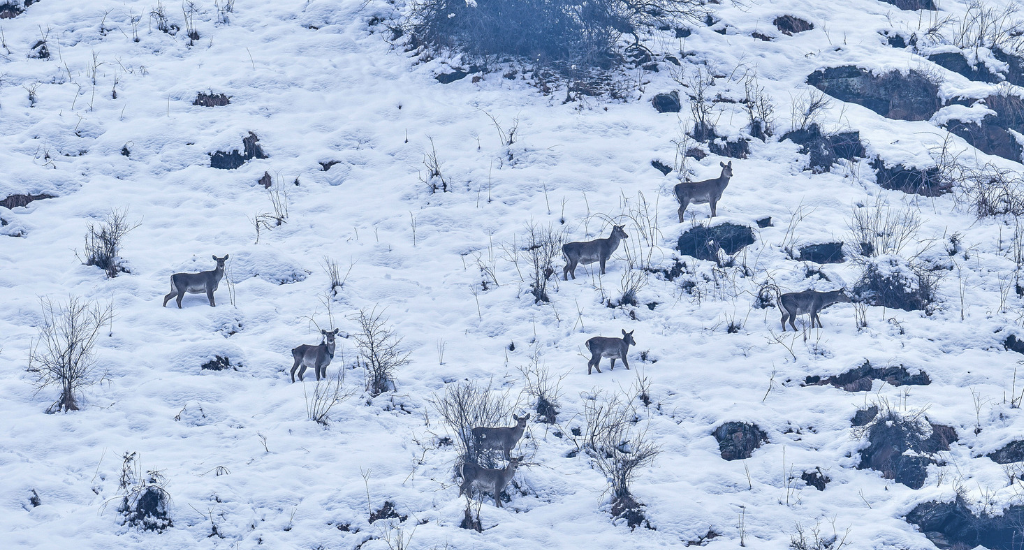
Photos that reveal Kashmir’s hidden wildlife treasures
Ghulam Ahmad Bhat, a forest guard who joined the wildlife department reluctantly, is now a passionate photographer who wants to make people interested in the rich natural fauna of the region.

Ghulam Ahmad Bhat, a forest guard who joined the wildlife department reluctantly, is now a passionate photographer who wants to make people interested in the rich natural fauna of the region.
Ghulam Ahmad Bhat, 50, has been following the same routine for the last decade. He leaves his house in Nishat, Srinagar, before dusk and enters the Dachigam Wildlife Sanctuary, where he guards and documents nature and its vibrant hues with wildlife photos.
Bhat joined the Department of Wildlife Protection of Jammu and Kashmir in the early 1990s after his father, who had also served as a wildlife guard, passed away.
Initially reluctant, Bhat became interested in wildlife gradually. Over the years, he has not only taken up the role of protecting the forest but also began documenting them for the wider world. In Dachigam National Park, where Bhat fulfills his duties during frosty nights, he captures a myriad of flora and fauna using his camera.

Encompassing an area of approximately 141 sq. km, Dachigam National Park is renowned for its population of hangul deer (Kashmiri stag), musk deer and other endangered animals. Their rare sightings can be experienced only within the park’s boundaries.
“It was the endangered hangul that captured my heart,” said Bhat, gesturing towards the peaks he has explored while capturing these rare animals in their natural habitat. “Now, I can’t imagine life without a glimpse of these animals. Nature is endearing. The more time you spend in nature, the more it captivates your heart.”
Over the last two decades, the hangul (Cervus hanglu hanglu) population has gradually increased by 50 percent in this national park.
Also Read: Will this stag party again?

“Based on the direct animal sightings, the mean population number of hangul was estimated to be 275 individuals at Dachigam National Park. Also, at Shikargah, in Tral Wildlife Sanctuary, which is known to be the second home of hangul, 14 were recorded through the camera,” the census report released in April 2023 said.
In the 1900s, the hangul had thrived, with a population of 3,000-5,000. The deer’s numbers dwindled to less than 200 in the early 1990s, down from 800-900 in 1988, as it fell victim to poaching for its meat, antlers and skin.
The census conducted in April revealed that the population of the animal increased from 261 in 2021 to 289 in 2023, marking a 10 percent rise.

The credit for this increase in hangul population can be attributed to officials like Bhat who, despite the challenges marking the insurgency-striken Kashmir, stay at the forefront to protect the animal.
What makes Bhat’s approach different from that of the others is that he not only facilitates his duties but also fosters a love for these species among people who cannot visit such core zones where animals roam freely.
“I got the idea of documenting these animals in 2016,” recalled Bhat. “People can’t venture into such places without proper training, which is why I decided to bring the animal world to them through my photographs.”
Also Read: The fascinating story of a bank manager who caught snakes to save nature

The diverse array of species showcased in Bhat’s portfolio is impressive. These include the hangul, the Himalayan serow, yellow-throated martens, black bears, leopards and even reptiles like the levantine or pit viper. With encouragement from wildlife officials, he has captured breathtaking photos of these animals as well as birds like the osprey and rare orange bullfinch.
Bhat has a significant presence on social media and his photos and videos garner thousands of views, likes and comments, spreading knowledge among people for Kashmir’s wildlife.
Rashid Naqash, regional wildlife warden, Kashmir, applauds Bhat for his passion, stating, “This endeavour has encouraged people to appreciate animals in a world marked by man-animal interactions.”
Despite the accolades that come his way, Bhat doesn’t seek to monetise his photos.

“My goal is not to make a living off my wildlife photography,” he said. “My only desire is for people to view images of these uncommon wildlife species.”
Her Life: “I’m proof that women can be wildlife conservationists”
The lead image shows a herd of hangul (Kashmir stag) in the snow-covered landscape of Dachigam Wildlife Sanctuary. (Photo by Ghulam Ahmad Bhat)
Mohsin Mushtaq and Rabia Mushtaq are freelance journalists based in Srinagar.